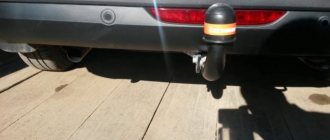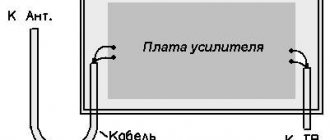The Moscow Specialized Vehicles Plant produces passenger trailers for a variety of needs. Models designed for transporting motor vehicles – motorcycles, ATVs, snowmobiles, etc. – are very popular. In order for the transportation of such expensive and fragile equipment to be as safe as possible, it is necessary that the trailer be equipped with a frame and covered with an awning. This design perfectly protects from dust, stones from oncoming and passing cars, and precipitation.
MZSA offers to order frames and awnings as additional equipment. However, topics are actively discussed on online forums: “should I buy a factory frame or make it myself?” Without insisting on any of the options, we note the advantages of each of them:
- Factory frame: no time required, all dimensions are perfectly adjusted to the dimensions of the trailer, the structure is covered with protective materials.
- Homemade frame: it will cost at least 2 times cheaper, it is possible to make it according to individual sizes.
Often, it is the desire to save money that prompts people to make an awning frame themselves. And if you consider that this is a very simple matter, this option has every chance of survival.
You need to know this
Firstly, this is a simplified list of requirements of GOST 37.001.220-80, given below:
- Permitted trailer weight up to:
- 1.8 t;
- Not heavier than the weight of the tug or half of it when the trailer hitch is without brakes;
- Allowed length no more than:
- 8 m;
- Not one and a half times longer than the car;
- Allowed width no more than:
- 230 cm;
- No wider than the car by 20 cm on both sides;
- Permitted height no more than:
- 3m;
- Not 1.8 times higher than the trailer wheel track;
- The center of gravity with a load is not higher than the track width multiplied by 0.725;
- Ground clearance is not less than the car's ground clearance;
- A homemade trailer for a passenger car can only be single-axle. (A twin axle is also a single-axle design, although it is called a two-axle design among car enthusiasts). The distance between the axes of the paired structure is up to 1 m;
- The trailer must have a load on each side of no more than 0.55% of its own weight;
- The load on the hitch is 25-100 kgf.
- The coupling device must be equipped with:
- A permanent cable or chain in case of sudden disconnection of the trailer hitch from the car while driving;
- Homemade anti-rollbacks (shoes);
- Jacking platform;
- Removable lever brake;
- Mudguards, fenders;
- Signboard for the sign;
- Stable support;
- A spare wheel similar to the car;
- Lighting fixtures, wiring and plug.
Factory sides
The ready-made solution in the form of extending the sides of a passenger car trailer differs for the models for which it is provided, as well as in height, material and sheet thickness. The competitive qualities of this option over homemade products are:
- The quality of the material and design in general.
- Optimality and compliance of sizes.
- Warranty period from the supplier or manufacturer.
- Easy to install and dismantle.
- Attractive view.
- Compliance with installed trailer models.
- No need for long-term work.
Video instructions for installing additional sides on the “Krepysh” trailer
How to increase the sides of a passenger trailer, using what materials, is up to you. The main thing is to accurately assess capabilities, cost, time and quality. The rest depends on the caravan model. However, before starting any modifications, it is important to consult with a professional or look up recommendations from knowledgeable drivers on the Internet.
A trailer is a vehicle that does not have an engine installed. It is designed to travel in conjunction with a car. Despite the apparent complexity of such a device for transporting goods, it is not difficult to make a trailer with your own hands. For successful work, you need to choose the right parts and materials, make sketches or drawings.
Possible improvements
I want to say right away that it’s impossible to consider literally all tuning options, even with a great desire. There are too many of them to fit into one material or even several articles.
If you're really interested in upgrading your caravan, you need to start with the basics. Namely, from the idea. Since you are not happy with the design in its current form and something needs to be changed, you need to understand what exactly is wrong and what you should strive for. And here the first difficulty arises, since there are many ideas, but many motorists simply do not have a clear definition. You have to go through different options, look for compromises and try to calm your ardor in impulses to do something that can later make your hair stand on end.
Let's take a regular flatbed trailer as a basis. After all, most often they are the ones who undergo tuning and all sorts of modifications.
What exactly the model or brand is doesn’t really matter. There is just a trailer from which you need to make something.
There are several options for what you can turn into an onboard vehicle for a passenger car. I advise you to decide right away, so that later you don’t have to stop halfway, change your mind and start implementing a completely different idea.
Transport trailers
The widespread use of semi-trailers and trailers is due to the additional convenience when transporting heavy loads. The vehicle bears only part of the load, which extends its service life. When unloading, you can save valuable time by unhooking the cart and leaving it in place, and unloading it at a convenient time. This option is convenient and is used for delivering goods between workshops of the same enterprise located at a certain distance.
All towed devices are divided into two groups:
- Special-purpose trailers allow you to take into account the needs of working with various loads, but there are quite a few universal vehicles for such work. Common types include heavy-duty semi-trailers, log trucks, panel trucks, cement trucks and other types of trailed equipment.
- General transport equipment includes flatbed, tilt and other trailers of various sizes designed for transporting heavy loads of any kind.
Application area
Let's imagine what modernized flatbed trailers that have gone through tuning stages can be used for.
- For relax. Even an on-board model can become a full-fledged mobile place for spending the night, going out into nature, barbecuing, for tourist trips and other delights of active recreation;
- For fishing and hunting. A common tuning option aimed at increasing functionality and load capacity. Also, often such tuning provides the ability to use a trailer as a sleeping place;
- For a snowmobile. The presence of an on-board model does not interfere with making it an excellent vehicle for transporting snowmobiles;
- For watercraft. A current and widespread modification option, in which the onboard is made into something like a boat trailer. Moreover, without compromising the possibilities of its use as a simple on-board model;
- For off-road use. Tuning aims to improve the vehicle's cross-country ability, which will require a number of measures.
Let's not forget about purely technical improvements, where the owner's main goal is to improve the basic characteristics and expand the capabilities of the trailed vehicle.
I propose to consider several tuning options separately and find out what you can do with your own hands.
Installation of awning
The simplest but most effective tuning. It is not only effective, but also spectacular. With the help of an awning, which is not included in the original package, you can expand the capabilities of the vehicle, increase its loading area, and use the trailer for larger purposes.
In terms of tuning of this kind, there are a couple of current options:
- Installation of a tarpaulin awning. The classic version requires preliminary installation of the frame under the tarpaulin and its subsequent tensioning. An outdated method of improvement that is losing its relevance;
- Using the lid. A plastic lid is a great alternative. A more reliable, durable, outwardly attractive option. No frame needed. But you will need to provide fasteners to secure the cover to the sides.
If you are willing to spend a lot of effort and money, then plastic will be the best solution.
The awning is too banal and has much less benefit than a durable plastic cover, complemented by security locks.
DIY trailer
Each shield should be secured with at least 4 bolts.
Metal structure
Extending the sides of a passenger trailer with welded metal panels is a more expensive method. However, such structures have a significantly greater safety margin. To implement the idea, you will need sheet metal, corners and a profile pipe. Corners are welded at the corners of the trailer, to which the profile sheathing is attached. Precisely cut to size sheets of metal are screwed to the assembled frame using metal self-tapping screws.
Read more: The appellate court issued a ruling
Purchase of factory structures
Specialized stores offer factory extensions for sale. The height of such structures is varied and can reach 50 centimeters. Advantages of factory extension sides:
- Fully galvanized construction.
- Quick installation/dismantling of sides.
- Extension sides look aesthetically attractive.
If you have any questions, you can ask our specialists by phone. They know exactly how to build up the sides of a passenger trailer with their own hands!
Choosing a method of extension
More often than not, the carrying capacity of passenger car trailers is designed for a larger volume of cargo than can be accommodated with a standard on-board configuration. Therefore, expanding the side of a trailer is a process that most owners of road trains face. Moreover, when the walls of a trailer vehicle increase by forty centimeters, the capacity of the body increases by at least seventy percent. This significantly increases the operational capabilities of this type of device.
If you look at the situation from a practical point of view, then you should think about extending the sides of a passenger trailer even before purchasing it. Even if the selected instance does not include this feature. In this case, you will have to do the modification yourself.
Owners of road trains prefer three options for increasing the height of the walls of a passenger trailer:
With a more detailed examination of these options, the description of the basic qualities is as follows.
Self-assembly of axles for a passenger car trailer
An ordinary car is poorly suited for transporting heavy and bulky cargo, so there is often a need to use a trailer. Buying such a device allows you to solve many problems, but for craftsmen, a much more preferable option is to assemble the trailer on your own. The cost of a homemade trailer can be several times less than the factory one. Today we will talk about one of the important components of the design of a trailer for a passenger car - its axle.
Is there any point in “chemicalizing”?
The MZSA plant produces a number of trailer models, which can additionally be equipped with factory frames and awnings. Here, for example, are some of these models:
| Photo | Model | dimensions | Purpose | Load capacity | Price |
| MZSA 817710.016 | 3180x1803x1102 mm | For the cottage and travel | 500 kg | RUB 58,580 | |
| MZSA 817702.012 | 3773x2000x873 mm | Transportation of motor vehicles and other cargo | 510 kg | RUB 49,420 | |
| MZSA 831132.111 | 4850×2060×913 mm | For commercial use and motorcycles | 905 kg | 120,000 rub. |
Wooden sides
The process of building up the sides of a passenger trailer using wood is as follows:
- Buy forty or fifty boards with antiseptic treatment.
- Drill several holes in the corner for subsequent fixation of the boards, file it and weld it to the standard structure.
- Adjust the board to the distance between the bolts and drill at the required points to connect to the corner.
- Connect the boards to the corners using bolts with a diameter of about five millimeters. Better is more.
The board should be cut after welding the corners, so as not to make mistakes with the measurements. It is also important to do processing in advance.
Before starting work
Before you get down to business, you need to decide - will the frame be collapsible or welded? The convenience and practicality of the collapsible design can hardly be overestimated - if necessary, it can be removed and neatly folded in the garage, where it will take up minimal space. The welded frame can only be removed from the trailer. Technologically, it is more difficult to produce a collapsible frame and it will take more time. Therefore, if you are sure that the frame with the awning will be permanently installed on the trailer, we recommend that you take a closer look at the welded structure.
The second thing that is important to think about in advance is the presence or absence of a bevel, as well as the height of the structure. The aerodynamic bevel allows for a reduction in windage and, accordingly, fuel consumption. At the same time, the capacity of the trailer suffers. The height of the frame should also not be excessive.
General characteristics of semi-trailer sides
A flatbed semitrailer is a mechanism that is used to transport small amounts of loose cargo. These can be vegetables, fruits, building materials. Frequently, carriers choose such a spare part as a side in order to provide the structure with greater rigidity than in a curtain-sided semi-trailer, and there is no need to secure pallets with cargo.
Material
The manufacture of sides for semi-trailers is carried out from different materials. If these are branded systems from brands such as Kegel, Schmitz, Krona, etc., then an aluminum profile is used for them.
But the price of such trailers is quite high, so many people prefer homemade products, such as converted tractor sides (made of wood, raw steel, hard plastic, etc.).
It is much cheaper than aluminum. But the reliability and comfort when using such products is significantly lower.
Specifications
The sides are made so that they can withstand mechanical loads and open easily. They are produced stacked or removable and folding. Some are remote controlled, but most sides must be opened manually. As for the height, it can be between 32 and 102 cm (depending on the type of side and the material from which it is made).
For your information! The highest sides are usually aluminum.
One, two - they took it!
How can you make life easier for yourself and your back when you have to load heavy things into a trailer? FORUMHOUSE member Serega567 offers this version of a lifting mechanism for loading a trailer: a U-shaped “bracket” is mounted on hinges in the lower part of the trailer. It is made from a pipe of sufficient cross-section so that it does not bend under a weight of 300 kg. The hinged mount at the bottom is also made removable so that this lift can be removed and not carried with you when not needed.
On the portal, Sergey provides a drawing of what such a lift could look like. True, the forum member never got to the point of practical implementation, although users recognized the scheme as suitable.
But a participant with the nickname AndreyKit assembled another version of a dump truck-loader trailer. Using a winch, you can lift loads into the trailer, and the folding body eliminates the need to unload bulk cargo manually.
The idea was that a crane could be used to drag and lift something that would be problematic on its own, curbs, barrels, etc. And the second function was to lift the dump truck. You can also make a grab bucket for a crane to load bulk materials into a trailer.
Source
Do-it-yourself trailer making technology
The first step will be to assemble the base, that is, the frame of the future trailer. It is its strength that will determine the service life and reliability of the structure. After welding the frame, it is necessary to create a connection unit between the trailer and the car and a special coupling for fastening.
Next comes the most crucial moment, namely the assembly of the axle. After this, all that remains is to add the flooring, side walls and finishing work, and you can move on to checking your homemade car trailer. If you cannot create such a structure with your own hands, then you can always contact any workshop where they will make a similar structure for you in the shortest possible time. The main advantage of such a trailer is that it is universal and can be used for any car.
Hi all! When buying a trailer, many people initially think about the prospects for its use. Others only realize after purchase that their vehicle is missing something and needs modernization and improvement.
Therefore, it is quite natural that today we will talk about the sides of a passenger trailer. We sell trailers without sides. They are called platforms. Some people need to increase or change only the rear side, others the front and sides.
The choice is made individually. Everything takes into account the volume of cargo that will be transported on the vehicle. If you increase the sides, this will significantly increase the capabilities of the trailer. Although it will not be possible to increase the carrying capacity by increasing the capacity, you will be able to transport larger and larger items, which was impossible with standard equipment.
Read more: Can a founder sign an agreement instead of a director?
Registration of a homemade trailer with the traffic police
The last step will be to register a homemade model of your own production. The traffic police will send the owner and the trailer for examination. It is important that the laboratory is accredited. It is necessary to save receipts for used components, and most importantly, a certificate for the hinge device, that same fastening element. In such circumstances, it is better to buy it. From standard papers you need: a copy of the owner’s and car’s passport, do-it-yourself photographs of a trailer for passenger cars, an application to the traffic police to register the towbar, a receipt for the state duty. If you had the documents, you first had to undergo a technical inspection, the positive decision of which recognized that the trailer complied with the standards, after which it was registered and numbers were issued. This procedure is described in more detail in this article.
Events and exhibitions are constantly held to showcase automotive technology. Motorists love to show off a light trailer they created with their own hands, which fits the style of the car, at least due to the color scheme. Today it is profitable to make a trailer yourself. Individual solutions add to the collection of technical insights when designing a trailer. Reliability and safety remain the constant rule.
Source
DIY making
In order to make a caravan yourself, you need to take care of purchasing some materials and tools. In order not to look for the necessary devices during work, they are purchased in advance. List of tools and materials:
Steel channel for frame. You should select or cut pieces that have a cross-section of 40x25 mm. You can use a square pipe with a transverse dimension of 40x40 mm. The cuts are determined by the master based on size considerations.- Sheet steel from which the sides of the trailer will be made. Its thickness should not be less than 1 mm. The dimensions of the finished pieces are calculated according to the drawing depending on the dimensions of the body.
- Plywood with a thickness of at least 16 mm to form the bottom of the body. This thickness is needed to take into account the strength when loading.
- To assemble the chassis, you can take suspension elements from common car brands. Volga, Moskvich, and Zaporozhets suspension brackets are often used; sometimes a bridge from a classic Zhiguli is used.
- The electrical elements of the equipment include direction indicators, brake lights, and marker lamps. Such assembled options can be purchased on the market in the form of ready-made kits. Sidelights from Gazelles and UAZs are often used.
- Fastening elements depend on the characteristic features of the trailer and its design. In order not to worry about the strength of the finished product on the road, you should not skimp on such connecting elements.
- Craftsman's tool for making the trailer itself. These tools should provide a minimum list of work. This includes an electric drill, grinder, pliers, a set of wrenches, and a jigsaw. Each master can add something to this list for convenience.
- A machine for welding metal, which you should have the skills to operate, or you should invite a specialist.
Reviews
Victor, Podolsk:
“I like the Oka walk-behind tractor, because I’ve been working with it for 6 years. There are no complaints about the operation, except that the engine is noisy, but the speed is normal, about 8 km per hour. I drove to the nearest market in mine, transporting bags of cement. The journey to the market took about 45 minutes, and the same time back. In the trailer I had room for several bags of cement, plus food for the dacha. The trailer was not a factory one, either Belarusian or domestic; to be honest, the manufacturer was not interested. Everything went well with the fastenings, I quickly connected it and started working. Even on inclines on the road, the technology does not let you down!”
Valery, Moscow region:
“I don’t consider homemade trailers at all. When the question arose about buying a trailer cart, I bought a product made by Gagarin. Regular TPM-350. Lasts as long as the walk-behind tractor itself. I didn't notice any downsides. Pros: comfortable seat, wide enough, there is a glove compartment and even a footrest. Now they seem to be releasing it without a glove compartment, and it’s a waste of time, because on the road you may need tools and all sorts of little things, but there’s nowhere to put it, just in your pockets. The weight pulls normally, up to 500 kg with my weight being almost a hundred - it just fits. On sand, a walk-behind tractor with a cart will slip 100%, but on asphalt, even uphill, it goes well and quickly.”
Metal constructions
Metal exhibits more stable qualities when compared to wood. Although the cost for this extension option is higher. Sheet metal is used to increase the sides of a passenger trailer. Most often galvanized, stainless steel or aluminum. The material is complemented by metal corners and a profile. The process for making the extension is as follows:
- Cut the corners by making holes in them. Weld to the trailer frame.
- Build a profile sheathing over the corners.
- Cover the structure with sheets of metal or mesh using welding or bolting.
Two-axle dump trailer with metal sides
Introduction
It is no secret that an awning for a passenger trailer, made from high-quality modern material, has characteristics such as durability and good resistance to any temperature. Careful, and most importantly, correct operation helps extend the life of such coating up to 15 years. After the expiration date, more precisely, 10–12 years, signs of wear appear on the fabric, which are manifested by a lack of former elasticity and strength. It is worth noting that it is very difficult to buy a factory awning that could ideally fit under the frame of your own trailer. In order to purchase the “correct” awning that will fully satisfy all the owner’s requirements, one should take into account the fact that the areas where the fabric comes into contact with the metal rods of the frame must be additionally sealed, which will allow for a tighter fit. No manufacturer of standard coatings will be able to correctly calculate the distance between the posts without measuring the specific trailer. In such a situation, there is only one true solution - to make an awning for the trailer yourself.
How to do it yourself
If you are skilled and have the necessary equipment, it is possible to make semi-trailer parts yourself. First of all, it is advisable to find a drawing. Various modifications of them are available on the Internet, so it’s possible to go through this stage.
Next, you need to decide what material the sides will be made of. Take into account the operating features of the semi-trailer and its dimensions. If you need to transport building materials or vegetables, a wooden fence will do just fine.
For longer trips or the ability to attach pallets to the side, it is recommended to make the sides at least from steel. They are more durable and strong. In addition, it is easier to equip metal sides with various movable systems to make them convenient to remove and disassemble.
The aluminum profile is absolutely rightly recognized as the best material for the product. It is lightweight, does not create a large load on the platform, is durable and practical.
But if you have already decided to have frames made of such material, then it is easier to buy them ready-made.
It is also important to make the side frame reliable. This is a load-bearing structure that will bear the main load. It must be made of channels or very durable pipes.
Seat - tool box
All metal parts are painted with black primer-enamel for rust, and the body and tool box are sheathed with galvanized iron roofing, which is mounted on ordinary blind rivets. The frame of the tool box is welded from a 20 mm angle and has dimensions: L 70 x W 34 x H 30 cm. The seat is made of a piece of chipboard and foam rubber, covered with dermantine. There is a lock embedded on the side (see photo).
The dimensions of this box were not chosen by chance, because there is a need to transport a chainsaw, an ax and a can of gasoline. And as it turned out later, the long seat is more comfortable when turning. The bottom of the trailer was made from two scraps of waterproof OSB 12mm thick. Subsequently, I will screw a sheet of galvanized roofing on top.











